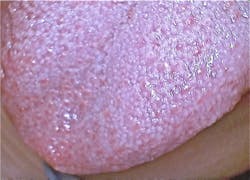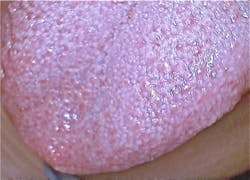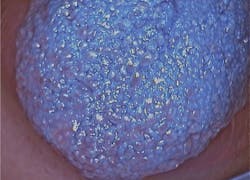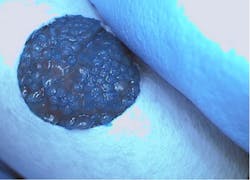A Patient Is a Supertaster!
BY NANCY W. BURKHART, BSDH, EdD
Your patient is Andrea, a 37-year-old female who just arrived for her recare visit with you. You have prepared the supplies that you will need, modifying what you normally use since Andrea complains about the tastes and scents in the office. Over the past few years, you have identified a prophy paste that Andrea seems to be able to tolerate without too many complaints because the paste is a low-flavored variety.
Andrea does not react well to any products that are highly flavored or highly scented. You always remember to make sure that you have not used any body products with a perfumed scent on the day of her visit. Sometimes, she even reacts to detergents that you may have used to wash your scrubs. Do you think that Andrea could be a supertaster?
What is a supertaster?
The term supertaster appeared in "Food Technology" papers in 1991, written by Dr. Linda Bartoshuk who has conducted studies on supertasters. Supertasters comprise about 15% to 25% of the population; nontasters comprise the other end of the continuum, accounting for another 25% of the population. The rest of the population falls in the middle range.
Supertasters describe themselves as having a strong aversion to certain foods and liquids. They usually remember disliking certain vegetables for as long as they can remember, dating back to early childhood. The strongest aversion tends to be with foods that have a bitter taste such as broccoli, kale, brussels sprouts, and other dark green vegetables. Supertasters will often use larger quantities of salt in order to mask the tastes of certain foods. However, most supertasters tend to just stay away from the foods that taste bitter.
The reaction to both taste and smell may explain why some children may actually gag when they encounter strongly flavored products that are typically used in the dental office, such as certain flavors of prophy paste and fluoride products. Since we know that taste and smell are intertwined, this certainly makes sense. Some patients can detect the scent of an anesthetic, the scent of tooth material that has been drilled, scents of pumice, and flavored pastes along with the scent of many items that are routinely used in a dental office.
How does one become a supertaster?
A supertaster does not choose to cultivate certain tastes. They are genetically programmed to react to various chemicals in the environment. Supertasters tend to have other family members who are also supertasters, such as siblings, parents, and grandparents. Supertasters dislike bitter, very sweet, and very fatty products.
Researchers know that the reaction to "bitter taste" may have been an innate defense mechanism that protects us from plants that may be poisonous in the environment. It is known that some animals such as dogs have an innate sense to leave plants alone that may be dangerous to them. Many genes have been linked to various taste sensations, and taste receptors have been found throughout the body, including the gut and the nose. The taste gene associated with the bitter taste is TAS2R38.
Supertasters tend to gravitate toward occupations involving food such as chefs, tasters who make a living with their keen sense of taste, and those in catering services, etc. They are also known to either "love" certain foods or "hate" them intensely. The taste sensation that supertasters have allows them to actually discern the products comprising a certain dish that others may love (but have no idea why the dish is consumed so much).
Supertasters react to a chemical called PROP or PTC. These chemicals produce a similar reaction when supertasters eat green vegetables such as kale, green peppers, and broccoli. Other items that tend to be unpleasant to supertasters are dark chocolate, grapefruit, radishes, and coffee. Supertasters also tend to dislike high fatty types of foods such as a fatty beef. To a supertaster, they are more than intense in texture and unbearably bitter.
Supertasters are genetically programmed to react to PROP or PTC with extreme intensity. Web companies do sell taste strips that are infused with PROP and will detect a supertaster. A nontaster and those who fall into a midrange of tasting, as most of the population does, will have different sensations from bland to barely bitter when using the chemical strip test to detect this characteristic. Nontasters will not be able to taste the PROP or PTC. The general population may find the taste slightly bitter but not terribly objectionable. However, the supertaster will find it to be extremely bitter and almost intolerable in many cases. Candy or mints are often given to supertasters after reacting in order to diminish the bitter taste from the strips.
Interestingly, research indicates that nontasters tend to have a greater preference for alcohol and actually consume more alcoholic beverages. Taste preferences tend to vary with age and some research supports the fact that the inclination to avoid bitter may wane with age and after menopause in women.
What are the benefits or the drawbacks?
It appears that most individuals know from childhood that they have peculiar taste sensations and food choices, but they don't really understand why. Knowing a child is a supertaster could be very beneficial, because parents tend to push green vegetables toward their children at an early age.
Recent studies by Shetty et al. (2014) found that supertasters actually do not care for sweet foods. In this study, children who were supertasters were found to have less caries than their counterparts who were nontasters. The nontasters, who had more carious lesions, tended to favor sweet/high sugar foods. High fructose corn syrup is linked to the obesity epidemic that we have seen in the United States over the past three decades.
Other studies have also reported that supertasters tend to be thinner because of their food choices and their tendency to avoid sweet/sugary foods. Supertasters have also been found to have better immune function and better ability to avoid bacterial sinus infections because of receptors in their nose. This is also a valuable characteristic to protect against respiratory infections. It is believed that this is an innate protective mechanism of the body.
One reported negative is that the lack of green vegetables may place them in a higher risk category for colon disease. Additionally, the increased use of salt may place supertasters at a higher risk for hypertension when used in larger quantities to mask bitter tastes.
A special appreciation for images and research on supertasters by Carol Perkins, RDH, in San Ramon, Calif. Carol is a dental hygienist in the office of Dr. Steven Chew in Pleasanton, Calif.
Clinically, it has been found that supertasters have an abundance of fungiform papillae (see Figure 1). Researchers believe that the taste buds are abundant in the fungiform papillae and contribute to the keen taste that supertasters exhibit. Taste receptors in other locations of the body may be more enhanced as well, such as the nose and gut. The fungiform stand out when the tongue is stained with basic blue food coloring (see Figure 2). The food color stains the filiform papillae, making the fungiform appear prominent. A test using a certain diameter hole punch is placed over the tongue and the numbers of fungiform are counted (see Figure 3). Researchers believe that both the number and the density of the fungiform are factors in the high intensity of taste in supertasters.
So, other than disease protection and susceptibility, why does it matter whether we study genes related to taste at all? Benson et al. (2012) sums up the importance of gene research nicely: "It matters because new knowledge about the molecular basis of food likes and dislikes in children, known to be a generation that will struggle with obesity and diabetes, may suggest strategies to overcome diet-induced diseases."
Could you or your patient be a supertaster?
As always, keep asking good questions and listen to your patients!
References
Benson PW, Hooker JB, Kock KL, Weinberg RB. Bitter taster status predicts susceptibility to vection-induced motion sickness and nausea. Neurogastroenterol Motil. 2012 Feb:24(2):134-40.
Duffy VB, Davidson AC, Kidd JR, Kidd KK, Speed WC, Pakstis AJ, Reed DR, Snyder DJ, Bartoshuk LM. Bitter receptor gene (TAS2R38), 6-n-propylthiouracil (PROP) bitterness and alcohol intake. Alcohol Clin Exp Res. 2004 Nov; 28(11):1629-37.
Hayes JE, Keast RSJ. Two decades of supertasting: where do we stand? Physiol Behav. 2011 October 24; 104(5): 1072-1074. Doi:10.1016/j.physbeh.2011.08.003.
Lee RJ, Cohen NA. The emerging role of bitter taste receptor T2R38 in upper respiratory infection and chronic rhinosinusitis. IS J Rhinol Allergy 2013 Jul-Aug: 274(14): 283-6.
Shetty V, Pooja BL, Hegde AM. PROP test: prediction of caries risk by genetic taste perception among the visually impaired children. Spec Care Dent. 34(1) 2014.
Resources
Lunch Break: How to know if you are a supertaster.http://live.wsj.com/video/how-to-know-if-youre-a-upertaster/9F993F2D-C387-4C5F-9428-2FCCCAA30BEE.html#!9F993F2D-C387-4C5F-9428-2FCCCAA30BEE
https://www.23andme.com/gen101/graphics/genetics/
Reddy, Sumathi. People Who Taste Too Much. WSJ.
http://online.wsj.com/news/articles/SB10001424127887324392804578362833147151480
SUPERTASTER.COM
https://supertaster.com
http://supertaster.com/category/learn-more/
NANCY W. BURKHART, BSDH, EdD, is an adjunct associate professor in the department of periodontics, Baylor College of Dentistry and the Texas A & M Health Science Center, Dallas. Dr. Burkhart is founder and cohost of the International Oral Lichen Planus Support Group (http://bcdwp.web.tamhsc.edu/iolpdallas/) and coauthor of General and Oral Pathology for the Dental Hygienist. She was a 2006 Crest/ADHA award winner. She is a 2012 Mentor of Distinction through Philips Oral Healthcare and PennWell Corp. Her website for seminars on mucosal diseases, oral cancer, and oral pathology topics is www.nancywburkhart.com.



